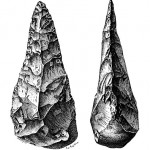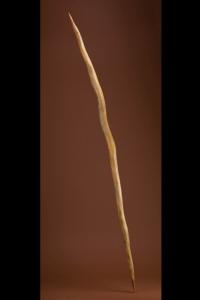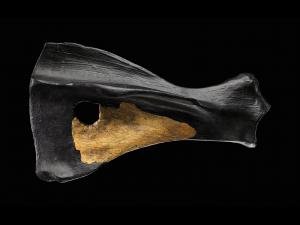The First List: From Throwing to Chronology
In the previous post, we looked at the earliest examples of organized information. These are primarily bone or antler artifacts with small slashes often incised over a period of time, indicating a chronologic list. Why would our first attempts at organized information be chronologic? Surprisingly the answer may involve our ability to throw.
I first started thinking about this after finding the work of neurophysiologist William H. Calvin, who theorized that our advanced throwing arm improved our hunting skills which in turn increased cognition. He believes throwing at moving targets enhanced our ability to plan, thus leading to modern mental capabilities.
To bolster his argument, Calvin suggested that the ubiquitous prehistoric hand axes were actually throwing devices. These hand axes were built and used by early humans and pre-humans for millions of years in Africa. As hominins migrated to Europe, Asia and the Americas, they brought their flint knapping skills with them, always improving the technology, as hominins like to do. The palm-sized tools tend to be symmetrical, narrow at the top, wide at the base, with a very sharp edge all around.
Several tests found the hand axes to be aerodynamic. Calvin suggested hominins threw them into a herd of mammals, not to kill but to surprise the one that got hit. The victim and the herd would then bolt, dispersing the animals. In all the commotion, one of the prey might trip and that would be the one the hominins ate for dinner.
Unfortunately, Calvin was wrong about that. The most thorough analysis of hand axes indicates they were used for butchering, not throwing. John Mitchell, an associate of Mark Roberts at the Boxgrove site in England, had a professional butcher, Peter Dawson of Oxford, use several hand axes on a deer carcass. Apparently if you know what you’re doing, they work great. As Roberts stated in his book with Michael Pitts, Fairweather Eden, “Any aerodynamic properties . . . are simply incidental” (2000, p. 289).
Just because Calvin was wrong about hand axes, doesn’t mean he was wrong about brain development or throwing. Spears from 400,000 BC were discovered by Hartmut Thieme at a site in Schoeningen, Germany. They are made from spruce tree trunks where the hardest part is at the base of the tree. That hardness forms the point of the spear. The weight of the projectile is heaviest about a third of the way up the shaft, just like a modern competition javelin
As usual, these spears are controversial in terms of the date of the artifacts, the effective penetration of the projectile, and the physiological ability of pre-humans to throw. That lack of throwing ability was challenged by a June, 2013 study in Nature. Researchers had Harvard baseball players throw while wearing braces that replicated the mechanics of the pre-human arm and shoulder. Their results suggest that hominins could throw accurately much earlier than previously believed.
The Boxgrove site is 100,000 years older than Schoeningen. Roberts’ team didn’t find any wooden spears. But they do have a scapula from a butchered horse with a round hole that seems to have been made by a projectile. Forensic analysis indicates the spear was propelled with a throwing device that allowed a hominin to throw faster, farther, and harder. This is a preliminary finding and is controversial considering that some researchers don’t believe pre-humans could even throw, let alone build a throwing device. For now, Pitts and Roberts make this comment about the hole in the scapula, “We are not saying that it was made by a spear thrown by Man. . . . We are saying that at the moment we cannot think of any other explanation” (2000, p. 267).
So Calvin may have it right about our ability to plan a throw possibly leading to improved cognition. But there’s more from Boxgrove about planning skills. The researchers there, including Francis Wenban-Smith and Phil Harding, made stone hand axes themselves and discovered it’s not so easy. Today’s Boxgrove flint knappers say it’s similar to playing chess. You have to plan ahead five or six steps, “if you follow the path of least resistance, you will remove parts of your axe” (Pitts & Roberts, 2000, p. 298).
The artifacts at Boxgrove are from half a million years ago. The chronologic bones and antlers of the Upper Paleolithic are only from 10,000 to 30,000 BC, plenty of time to learn how to plan. It’s no wonder when humans were ready to leave the archaic and move on to the future, they built a chronologic planning tool.
Reference
Michael Pitts and Mark Roberts (2000). Fairweather Eden: Life Half a Million Years Ago as Revealed by the Excavations at Boxgrove. New York: Fromm International.
Graphics
French hand axe, possibly from 500,000 BC. Wikimedia Commons. http://commons.wikimedia.org/wiki/File:Biface.jpg
“Three wooden spears like this one were found at Schöningen, Germany.” Chip Clark, Smithsonian Institution. http://humanorigins.si.edu/evidence/behavior/oldest-wooden-spear
Model of pierced Boxgrove horse scapula. James Di Loreto & Donald H. Hurlbert, Smithsonian Institution. http://humanorigins.si.edu/evidence/behavior/punctured-horse-shoulder-blade








 Follow
Follow